小鼠子宫内膜异位症模型英文文献
子宫内膜异位症大鼠模型研究进展
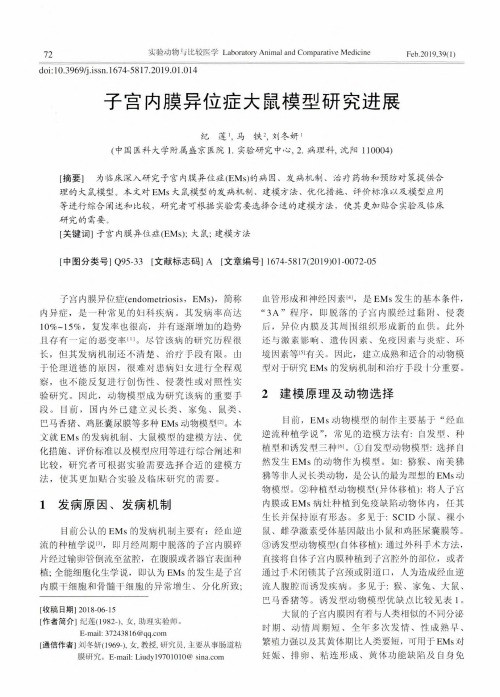
doi:10.3969/j.issn.l674-5817.2019.01.014子宫内膜异位症大鼠模型研究进展纟己莲I,马铁2,刘冬妍I(中国医科大学附属盛京医院1.实验研究中心,2.病理科,沈阳110004)[摘要]为临床深入研究子宫内膜异位症(EMs)的病因、发病机制、治疗药物和预防对策提供合理的大鼠模型。
本文对EMs大鼠模型的发病机制、建模方法、优化措施、评价标准以及模型应用等进行综合阐述和比较,研究者可根据实验需要选择合适的建模方法,使其更加贴合实验及临床研究的需要。
[关键词]子宫内膜异位症(EMs);大鼠;建模方法[中图分类号]Q95-33[文献标志码]A[文章编号]1674-5817(2019)01-0072-05子宫内膜异位症(endometriosis,EMs),简称内异症,是一种常见的妇科疾病。
其发病率高达10%~15%,复发率也很髙,并有逐渐增加的趋势且存有一定的恶变率⑴。
尽管该病的研究历程很长,但其发病机制还不清楚、治疗于段有限。
山于伦理道德的原因,很难对患病妇女进行全程观察,也不能反复进行创伤性、侵袭性或对照性实验研究。
因此,动物模梨成为研究该病的重要手段。
目前,国内外已建立灵长类、家兔、鼠类、巴马香猪、鸡胚囊尿膜等多种EMs动物模型⑷。
本文就EMs的发病机制、大鼠模型的建模方法、优化措施、评价标准以及模型应用等进行综合阐述和比较,研究者可根据实验需要选择合适的建模方法,使其更加贴合实验及临床研究的需要。
1发病原因、发病机制目前公认的EMs的发病机制主要有:经血逆流的种植学说⑼,即月经周期中脱落的子宫内膜碎片经过输卵管倒流至盆腔,在腹膜或者器官表面种植;全能细胞化生学说,即认为EMs的发生是子宫内膜干细胞和骨髓干细胞的异常增生、分化所致;[收稿日期]2018-06-15[作者简介]纪莲(1982-),女,助理实验师。
E-mail:37243816@[通信作者]刘冬妍(1969-),女,教授,研究员,主要从事肠道粘膜研究。
子宫内膜异位症动物模型制备方法研究概况

2020年第21巻第6期•“"阳每天&是新)”。
河-)./-012&无法“两78进同一条河-”。
习惯于ABC苹果)人永远也.会发现苹果内)NO星图案。
固有)学科WXTYZ成为]难以'掉)有色眼镜,请想一想它)局限,再看一看其他学科)发展,q意和灵U就产生了。
子宫内膜异位症动物模型制备方法研究概况Research progress on preparation methods of animal models of endometriosis孙瑞英,崔轶凡(山西中医药大学,山西晋中030619)摘要子宫内膜异位症(EMT)是一种严重影响妇女生活质量的妇科常见疾病,当前的手术及激素治疗效果不彻底,复发率高,可能与EMT的病因和发生机制尚不清晰有关,已成为妇产科领域研究的热门,EMT动物模型的构建是探求EMT的发生、发展以及诊治方法的重要方式,为EMT的研究提供了实验载体。
选取适当的动物模型有利于进一步揭露EMT的病因、发病机制和临床疗效评判。
因为仅有人和非人灵长类可以自觉形成EMT,制约了对EMT的探索,所以构建规范的动物模型已是探索EMT机制的重要因素的一部分。
关键词子宫内膜异位症;动物模型;造模方法中图分类号:R711.71文献标识码:A D01:10.19763/ki.2096-7403.2020.06.20子宫内膜异位症(endometriosis,EMT)是一种具有活性的子宫内膜组织在宫腔被覆盖的黏膜外生长的雌激素依赖性疾病。
在中医学里并无EMT 的病名,根,病=症”=病”“癥范畴。
目前对该病的发病机尚,西药,具有的发,大的生活。
学的,在EMT患发病的,能对对照研究,也能性研究。
,创的EMT,有一研究病学亍学,对发病机制、研发新药中药用机的用,有该疾病。
EMT的,性,EMT的发病机尚,的一的。
并EMT在一的题,用范畴潜在的限性都要充分考虑。
研究总结近20年来EMT的发展经验,对各种EMT动物的现状题作出简述。
Endometriosis子宫内膜异位症
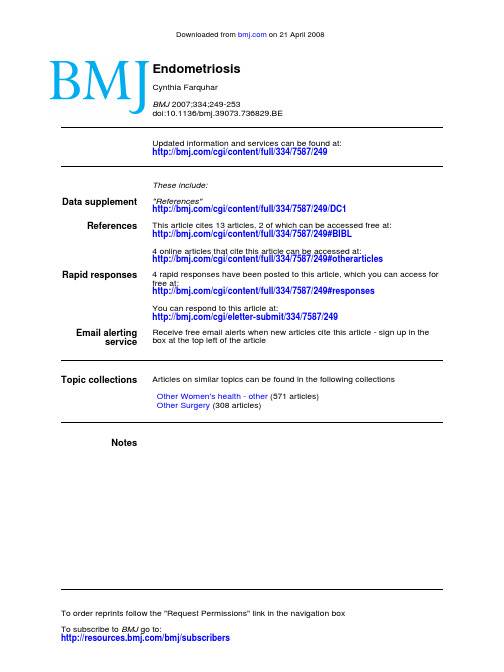
doi:10.1136/bmj.39073.736829.BE2007;334;249-253BMJCynthia FarquharEndometriosis/cgi/content/full/334/7587/249Updated information and services can be found at:These include:Data supplement/cgi/content/full/334/7587/249/DC1"References"References/cgi/content/full/334/7587/249#otherarticles 4 online articles that cite this article can be accessed at:/cgi/content/full/334/7587/249#BIBL This article cites 13 articles, 2 of which can be accessed free at: Rapid responses/cgi/eletter-submit/334/7587/249You can respond to this article at:/cgi/content/full/334/7587/249#responses free at:4 rapid responses have been posted to this article, which you can access forservice Email alertingbox at the top left of the articleReceive free email alerts when new articles cite this article - sign up in the Topic collections(308 articles)Other Surgery (571 articles) Other Women's health - otherArticles on similar topics can be found in the following collectionsNotesTo order reprints follow the "Request Permissions" link in the navigation box/bmj/subscribers go to:BMJ To subscribe toCliniCal ReviewGynaecology, National Women’s Hospital, University of Auckland, Auckland, New Zealand Correspondence to:c.farquhar@aucklanBMJ 2007:334:249-53doi: 10.1136/bmj.39073.736829.BEEndometriosisCynthia FarquharFor the full versions of these articles see What is endometriosis?Endometriosis is a chronic condition characterised by growth of endometrial tissue in sites other than the uter-ine cavity, most commonly in the pelvic cavity, includ-ing the ovaries, the uterosacral ligaments, and pouch of Douglas (fig 1). Common symptoms include dysmenor-rhoea, dyspareunia, non-cyclic pelvic pain, and subfertil-ity (table 1). The clinical presentation is variable, with some women experiencing several severe symptoms and others having no symptoms at all. The prevalence in women without symptoms is 2-50%, depending on the diagnostic criteria used and the populations stud-ied.1 The incidence is 40-60% in women with dysmenor-rhoea and 20-30% in women with subfertility.w1-w3 The severity of symptoms and the probability of diagnosis increase with age.w4 The most common age of diagno-sis is reported as around 40, although this figure came from a study in a cohort of women attending a family planning clinic.w5 Symptoms and laparoscopic appear-ance do not always correlate.2 The American Society for Reproductive Medicine has published a classification of severity of endometriosis at laparoscopy.w6What are the causes of endometriosis?Several factors are thought to be involved in the development of endometriosis. Retrograde menstrua-tion remains the dominant theory for the develop-ment of pelvic endometriosis, though as this is almost universal it is unlikely to be the sole explanation.w7-w9 The quantity and quality of endometrial cells, failure of immunological mechanisms, angiogenesis, and the production of antibodies against endometrial cells may also have a role.w10 w11 Embryonic cells may give rise to deposits in distant sites such as the umbilicus, the pleural cavity, and even the brain.w8 w9What are the risk factors for endometriosis?Risk factors generally relate to exposure to menstrua-tion: early menarche and late menopause increase the risk whereas the use of oral contraceptives reduces.w5What is the natural course of endometriosis?Studying the natural course is difficult because of the need for repeat laparoscopy. T wo studies in whichl aparoscopy was repeated after treatment in women given placebo, however, reported that over 6-12 months, endometrial deposits resolved spontaneously in up to a third of women, deteriorated in nearly half, and were unchanged in the remainder.w12 w13BMJ | 3 fEBRUARY 2007 | VolUME 334249SuMMaRy pointSMedical treatmentAvoid prescribing medical treatment for women who are trying to conceiveThe simpler treatments—such as the combined oral contraceptive pill, oral or depot medroxyprogesteroneacetate, and the levonorgestrel intrauterine system—are as effective as the gonadotrophin releasing hormone (GnRH) analogues and can be used long termSurgical treatmentLaparoscopic excision or ablation at time of diagnostic laparoscopy if possibleEndometriomata (large cysts of endometriosis) are best stripped out instead of drainage and ablationRecurrencesIn the five years after surgery or medical treatment 20-50% of women will have a recurrenceLong term medical treatment (with or without surgery) has the potential to reduce recurrence but evidence based research is lackingtable 1 | Common presentations of endometriosisSymptomAlternative diagnoses Recurrent painful periods Adenomyosis, physiologicalPainful intercourse Psychosexual problems, vaginal atrophy Painful micturitionCystitisPainful defecation during menstruation Constipation, anal fissuresChronic lower abdominal pain Irritable bowel syndrome, neuropathic pain, adhesions Chronic lower back pain Musculoskeletal strainAdnexal masses Benign and malignant ovarian cysts, hydrosalpingesInfertilityUnexplained (assuming normal ovulation and semen parameters with patent tubes)CliniCal ReviewDiagnosis of endometriosisWhat features of history and examination are important?In women of reproductive age who present with recurrent dysmenorrhoea or pelvic pain you should take a full history of reproduction and carry out a pelvic examination. The cyclical nature of the pain and the relation of the pain to menstruation points to the diagnosis of endometriosis. Painful micturition, defecation, and dyspareunia are also associated. In young women you should consider other diagnoses such as pelvic infection, problems in early preg-nancy, ectopic pregnancy, ovarian cyst torsion, and appendicitis (table 1). During pelvic examination, tenderness in the posterior fornix or adnexa, nod-ules in the posterior fornix, or adnexal masses may indicate endometriosis. Adolescents presenting with dysmenorrhoea do not require a pelvic examination as disease is uncommon.How is endometriosis diagnosed?Transvaginal ultrasonography can reliably detect endometriomata (cysts of endometriosis), but fail-ure to reveal cystic structures does not exclude the diagnosis of endometriosis.3 w14 Magnetic resonanceimaging is increasingly used to identify subperitoneal deposits, although retroversion, endometriomata, and bowel structures may mask small nodules.4 w15Although concentrations of the cancer antigen CA125 are slightly raised in some women with endometriosis, the test neither excludes nor diag-noses endometriosis and is not considered useful in establishing the diagnosis.5 The threshold for surgery is unlikely to be influenced by the CA125 concentra-tion, and the guidelines from the Royal College of Obstetricians and Gynaecologists described CA125 as having only limited value as either a screening or a diagnostic test.6 Laparoscopy is the only diagnostic test that can reliably rule out endometriosis. It is also accurate in detecting endometriosis and is considered the standard investigation.6What are the indications for laparoscopy?Many young women experience dysmenorrhoea (about 60-70%), and unless there are other features to indicate endometriosis laparoscopy is not recom-mended.w16 Some women will require further inves-tigation to guide management. For adolescents who present with dysmenorrhoea, the recommended approach is to first prescribe non-steroidal anti-inflammatory drugs (NSAIDs) and oral contracep-tives.w17 w18 The lack of measurable pain relief with these drugs is usually an indication for further inves-tigation.w19 Other indications for laparoscopy include severe pain over several months, pain requiring sys-temic therapy, pain resulting in days off work or school, or pain requiring admission to hospital.What are the effective medical treatments?Treatment options for medical therapy include oral contraceptives, progestogens, androgenic agents, and gonadotrophin releasing hormone (GnRH) analogues. All suppress ovarian activity and menses and atrophy of endometriotic implants, although the extent to which they achieve this varies. There have been few randomised controlled trials of medical treatment versus placebo, although many trials have250 BMJ | 3 fEBRUARY 2007 |VolUME 334Fig 1 | Mild pelvic endometriosis seen at the time ofdiagnostic laparoscopy. Arrows show typical endometriotic deposits (reproduced with permission of dr d A Hill)table 2 | Medical treatment* for endometriosisdrugMechanism of actionlength of treatment recommended Adverse eventsnotesMedroxyprogesterone acetate/progestagens Ovarian suppression Long termWeight gain, bloating, acne, irregular bleedingMay be given orally or byintramuscular or subcutaneous depot injectionDanazol Ovarian suppression 6-9 months Weight gain, bloating, acne, hirsutism, skin rashes Adverse effects on lipid profiles Oral contraceptiveOvarian suppressionLong termNausea, headachesCan be used to avoidmenstruation by skipping the placebo pillsGnRH analogueOvarian suppression bycompetitive inhibitor of GnRH analogue6 monthsHot flushes, other symptoms of hypo-oestrogenism By injection or nasal spray onlyLevonorgestrel intrauterine systemEndometrial suppression; ovarian suppression in some womenLong term use but change every 5 years in women <40 yearsIrregular bleedingAlso reduces menstrual blood lossGnRH=gonadotrophin releasing hormone.*Decisions about medical therapy will depend on patient’s choice, available resources, plans for fertility, and ongoing symptoms. Side effect profile may influence choice.on 21 April 2008 Downloaded fromCliniCal Reviewcompared different types of medical treatment.7-10 All medical treatments are similarly effective in relieving pain during treatment (table 2).The side effect profiles are important in decid-ing treatment choices. Progestogens are associated with irregular menstrual bleeding, weight gain, mood swings, and decreased libido. The side effectsa ssociated with danazol include skin changes, weight gain, and occasionally deepening of the voice, and it is infrequently prescribed now. GnRH analogues dramatically lower oestrogen concentrations, and side effects include the development of menopausal symptoms and the loss of bone mineral density with long term use (both reversible). Oestrogen therapy in an add back regimen is useful for preventing side effects with GnRH analogues.10 In the randomised controlled trials comparing subcutaneous depot medroxyproges-terone acetate (SC-DMPA) with GnRH analogues the bone loss was less with the progesterone during treat-ment.w20 w21Recurrence of painful symptoms after six months of medical treatment may be as high as 50% in the 12-24 months after the treatment is stopped.w22 w23 Recur-rence may in part be because large lesions respond poorly to medical treatment. It is generally accepted that endometriomata are not amenable to medical treatment, although temporary clinical relief may be achieved.The levonorgestrel intrauterine system (LNG-IUS) is an established treatment for heavy menstrual bleed-ing but can also be used for dysmenorrhoea and endometriosis.11 w24 In one study only 10% of women who had a levonorgestrel intrauterine system after surgery for endometriosis had moderate or severe dysmenorrhoea compared with 45% of the women who had surgery only.12 In a trial of 82 women with endometriosis the levonorgestrel intrauterine system had similar effectiveness to GnRH analogues, but the potential for long term use of this system is advanta-geous if the woman does not want to conceive.13 It has also been used in women with rectovaginal disease.14 In the future aromatase inhibitors may have a thera-peutic role in endometriosis as they inhibit oestrogenproduction selectively in endometriotic lesions, without affecting ovarian function.w25is surgery or medical treatment more effective?There are no randomised controlled trials comparing medical versus surgical treatments for the management of endometriosis, and the decision about medical or surgical treatment at the time of diagnosis will depend on several factors including patient’s choice, the avail-ability of laparoscopic surgery, the desire for fertility, and concerns about long term medical therapy.What are the effective surgical strategies?Surgery for endometriosis can be performed laparo-scopically or as an open procedure. It entails exci-sion or ablation (by laser or diathermy), or both, of the endometriotic tissue with or without adhesiolysis. There are few trials of laparoscopic treatment.14 15 Surgi-cal excision of endometriosis results in improved pain relief and improved quality of life after six months compared with diagnostic laparoscopy only.14 In one of the trials laparoscopic treatment also included uter-ine nerve ablation (LUNA),15 and pain improvement persisted for up to five years in more than half of the women.w26 About 20% of women do not report any improvement after surgery.14No randomised controlled trials have compared laser versus electrosurgical removal of endometriosis, and only one small trial, with inconclusive results, com-pared excision versus ablation.w27How often does endometriosis recur after surgery?Recurrence of endometriosis after laparoscopic surgery is common.16 w26 Even with experienced laparoscopic surgeons, the cumulative rate of recurrence after five years is nearly 20%.17 Another study reported recur-rence of dysmenorrhoea in almost a third of women within one year of laparoscopic surgery in women who received no other treatment.16What is the role of uterine nerve ablation at the time of laparoscopy?Randomised controlled trials of laparoscopic uterine nerve ablation at the time of laparoscopic excisionBMJ | 3 fEBRUARY 2007 | VolUME 334251Fig 2 | laparoscopy of an enlarged ovary containing an endometriotic cyst leaking “chocolate” fluid (arrow)(reproduced with permission from Professor Peter Braude)on 21 April 2008 Downloaded fromCliniCal Reviewof endometriosis compared with laparoscopic exci-sion only showed no evidence of benefit, although there was limited evidence of benefit with presacral neurectomy.18What is the evidence for surgery in women with endometriomata?Randomised controlled trials comparing excision or drainage and ablation for endometriomata ≥3 cm reported that recurrences were reduced and subsequent spontaneous pregnancy increased in the women who underwent excision (fig 2).19 Although excisional surgery of the capsule could lead to removal of normal ovarian tissue and result in reduced ovarian reserve,20 w28 there is no evidence that this occurs, whereas a recurrence of the endometriomata will inevitably mean further surgery.19What is the best approach in women with rectovaginal disease?Rectovaginal endometriosis presents surgical challenges because of difficult access and the possibility of injury to the bowel. Although reported long term outcomes are encouraging with advanced laparoscopic techniques, there are few prospective studies and no randomised controlled trials.16 17 One small study of the levonor-gestrel intrauterine system in women with rectovaginal endometriosis found improved dysmenorrhoea, pelvic pain, and dyspareunia after one year.w29 A trial com-paring oestrogen and progesterone combination with low dose progestogen in 90 women with rectovaginal disease reported substantial reductions at 12 months in all types of pain without major differences between groups.21 Overall, two thirds of patients were satisfied with this approach.Should women have hormonal treatment before surgery for endometriosis?Only one study has examined this question. There was no evidence of a difference in the difficulty of surgery in the women who had received preoperative hormonal treatment.w30Should women have hormonal treatment after conserva-tive surgery?There was no evidence of improved pain relief with postoperative hormonal treatment (including danazol, GnRH analogues, oral contraceptives, and medroxy-progesterone acetate) up to 24 months after surgery.11 The studies to date are small, however, and there is insufficient follow-up to rule out a benefit.What are the effects of hormonal treatment after oophorectomy (with or without hysterectomy)?There was no evidence of increased rates of recur-rence in women who had both ovaries removed and who were given nearly four years of combined hor-mone therapy, but the study was underpowered to detect clinically important differences.22What is the impact of endometriosis on fertility?Although management of pain may be the more immediate issue, the long term outcome of fertility should not be overlooked. Few studies have exam-ined this. A systematic review of medical treatment for women with infertility and endometriosis did not find evidence of benefit,7 and it is not recommended for women trying to conceive.6 23 A systematic review of laparoscopic treatment of endometriosis in women with subfertility suggested an improvement in pregnancy rate in the 9-12 months after surgery.w31 A second systematic review of laparoscopic excision compared with ablation endometriomata reported a fivefold increase in rate of pregnancy.19 There is the ongoing concern about ovarian reserve in women who have laparoscopic excision.20 w28 The other con-cern is the impact of endometriomata on artificial reproductive techniques.w32 The European Society for Human Reproduction and Embryology recommends surgery if endometriomata are ≥4 cm.23ConclusionEndometriosis should be suspected in any woman of reproductive age who presents with dysmenor-rhoea or chronic pelvic pain. Only laparoscopy can reliably identify endometriosis. If endometriosis is diagnosed at the time of laparoscopy, laparoscopic surgery should be the first choice of treatment, espe-cially in women of reproductive age with an endome-triomata. In women with endometriomata, the cyst252BMJ | 3 fEBRUARY 2007 | VolUME 334on 21 April 2008 Downloaded fromCliniCal Reviewwall should be stripped out, instead of drainage and ablation, as the recurrences are fewer and pregnancy rates improved. At present, there is no evidence of benefit of postoperative medical treatment but the levonorgestrel intrauterine system has the potential for long term use. In women who wish to conceive surgical, rather than medical, treatment should be offered.1 Fauconnier A, Chapron C. Endometriosis and pelvic pain:epidemiological evidence of the relationship and implications. Human Reprod Update 2005;11:595-606.2 Vercellini P, Trespidi L, De Giorgi O, Cortesi I, Parazzini F, CrosignaniGP. Endometriosis and pelvic pain:relation to disease stage and Endometriosis and pelvic pain: relation to disease stage and localization. Fertil Steril 1996;65:299-304.3 Alcazar JL, Laparte C, Jurado M, Lopez-Garcia G. The role oftransvaginal ultrasonography combined with color velocity imaging and pulsed Doppler in the diagnosis of endometrioma. Fertil Steril 1997;67:487-91.4 Kinkel K, Brosens J, Brosens I. Preoperative investigations. In:Sutton C, Jones K, Adamson D, eds. Modern management of endometriosis . Basingstoke: Taylor & Francis, 2006:71-85. 5 Mol BW, Bayram N, Lijmer JG, Wiegerinck MA, Bongers MY, vander Veen F, et al. The performance of CA-125 measurement in the detection of endometriosis: a meta-analysis. Fertil Steril 1998;70:1101-8.6 Royal College of Obstetricians and Gynaecologists. The investigationand management of endometriosis . London: Royal College ofObstetricians and Gynaecologists, 2006. (Green Top Guideline No 24.) /resources/Public/pdf/endometriosis_gt_24_2006.pdf7 Hughes E, Fedorkow D, Collins J, Vandekerckhove P. Ovulationsuppression for endometriosis. Cochrane Database Syst Rev 2003;(3):CD000155.8 Prentice A, Deary AJ, Bland E. Progestagens and anti-progestagensfor pain associated with endometriosis. Cochrane Database Syst Rev 2000;(2):CD002122.9 Selak V, Farquhar C, Prentice A, Singla A. Danazol for pelvic painassociated with endometriosis. Cochrane Database Syst Rev 2001;(4):CD000068.10 Sagsveen M, Farmer JE, Prentice A, Breeze A. Gonadotrophin-releasing hormone analogues for endometriosis: bone mineral density. Cochrane Database Syst Rev 2003;(4):CD001297.11 Yap C, Furness S, Farquhar C. Pre and post operative medicaltherapy for endometriosis surgery. Cochrane Database Syst Rev 2004;(3):CD003678.12 Vercellini P, Frontino G, De Giorgi O, Aimi G, Zaina B, Crosignani PG.Comparison of a levonorgestrel-releasing intrauterine device versus expectant management after conservative surgery for symptomatic endometriosis: a pilot study. Fertil Steril 2003;80:305-9.13 Petta CA, Ferriani RA, Abrao MS, Hassan D, Rosa E, Silva JC, et al.Randomized clinical trial of a levonorgestrel-releasing intrauterine system and a depot GnRH analogue for the treatment of chronic pelvic pain in women with endometriosis. Human Reprod 2005;20:1993-8.14 Abbott J, Hawe J, Hunter D, Holmes M, Finn P, Garry R. Laparoscopicexcision of endometriosis: a randomized, placebo-controlled trial. Fertil Steril 2004;82:878-84.15 Sutton CJ, Ewen SP, Whitelaw N, Haines P. Prospective, randomized,double-blind, controlled trial of laser laparoscopy in the treatment of pelvic pain associated with minimal, mild and moderate endometriosis. Fertil Steril 1994;62:696-700.16 Fedele L, Bianchi S, Zanconato G, Bettoni G, Gotsch F. Long-termfollow-up after conservative surgery for rectovaginal endometriosis. Am J Obstet Gynecol 2004;190:1020-4.17 Redwine DB, Wright JT. Laparoscopic treatment of completeobliteration of the cul-de-sac associated with endometriosis: long-term follow-up of en bloc resection. Fertil Steril 2001;76:358-65.18 Proctor ML, Latthe PM, Farquhar CM, Khan KS, Johnson NP. Surgicalinterruption of pelvic nerve pathways for primary and secondary dysmenorrhoea. Cochrane Database Syst Rev 2005;(4):CD001896.19 Hart RJ, Hickey M, Maouris P, Buckett W, Garry R. Excisional surgeryversus ablative surgery for ovarian endometriomata. Cochrane Database Syst Rev 2005;(3):CD004992.20 Wong BC, Gillman NC, Oehninger S, Gibbons WE, Stadtmauer LA.Results of in vitro fertilization in patients with endometriomas: is surgical removal beneficial? Am J Obstet Gynecol 2004;191:597-607.21 Vercellini P, Pietropaolo G, De Giorgi O, Pasin R, ChiodiniA, Crosignani PG. Treatment of symptomatic rectovaginalTreatment of symptomatic rectovaginal endometriosis with an estrogen-progestogen combination versus low-dose norethindrone acetate. Fertil Steril 2005;84:1375-87.22 Matorras R, Elorriaga MA, Pijoan JI, Ramon O, Rodriguez-Escudaro FJ.Recurrence of endometriosis in women with bilateral adnexectomy (with or without total hysterectomy) who received hormone replacement therapy. Fertil Steril 2002;77:303-8.23 European Society for Human Reproduction and Embryology. ESHREguideline for diagnosis and treatment of endometriosis . /guidelines.BMJ | 3 fEBRUARY 2007 | VolUME 334 253on 21 April 2008 Downloaded from。
子宫内膜异位症动物模型再评价

子宫内膜异位症动物模型再评价子宫内膜异位症(内异症)是指有生长功能的子宫内膜组织出现在子宫腔被覆黏膜以外的身体其他部位的疾病。
是一种激素依赖性、出血性、炎症性、遗传性疾病,临床症状可表现为盆腔痛、月经失调、不孕、盆腔包块等[ 1]。
自1860年首次报道该病以来,其发病机理至今尚未完全明了,它仍是令妇科专家们“迷惑的疾病”。
根据近年来的研究显示,内分泌异常改变有利于子宫内膜移位种植,未成熟卵泡黄素化可能是发生内异症的病因之一。
患者常伴有细胞和体液免疫功能的异常,有部分免疫球蛋白与补体的变化及细胞免疫反应异常,患者的血中与腹腔液中可发现多种自身抗体。
加强对本病的基础研究,特别是建立理想的动物模型模拟人类内异症,以便进行反复的、可控的实验,在动物身上进行病因病理、药物治疗等的研究,才能有助于尽快地攻克此病。
文献一子宫内膜异位症动物模型的构建1、材料与方法1. 1标本来源2002 年4月至2002年7 月因EM 入我院妇产科行腹腔镜诊治的患者8 例。
术后病理均证实为EM, 取其在位内膜及腹腔内膜异位囊肿壁。
1. 2实验动物[ 1]SCID 小鼠, 雌性, 8 周龄, 体重20~25g,46只, 由军事医学科学院实验动物中心提供SPF(specific -pathogen free) 条件饲养。
1. 3方法1. 3. 1标本处理标本置入盛有4ml DMEM 培养液(含100U/ml 青霉素, 100U/ml链霉素) 无菌瓶后, 置于冰壶, 快速送入实验室接种( 1h 内, 否则影响接种成功率)[ 1]。
标本用0. 1mol/L 的无菌PBS 漂洗3 次, 尽量洗去血块和粘液。
然后于无菌培养皿内等量分置, 分装入盛有 D MEM 液的无菌管内, 准备接种。
1. 3. 2动物处理用1%的戊巴比妥钠约0. 07ml 腹腔注射麻醉SCID 小鼠, 待小鼠麻醉后固定于操作板上, 腹部酒精消毒备皮, 夹起腹部皮肤, 用无菌小弯剪剪开0. 5cm 长的小口,将已备标本种植于皮下, 无菌丝线缝合及纱布包裹。
浅论二 ■ 英对小鼠异位子宫内膜影响的分子机制研究
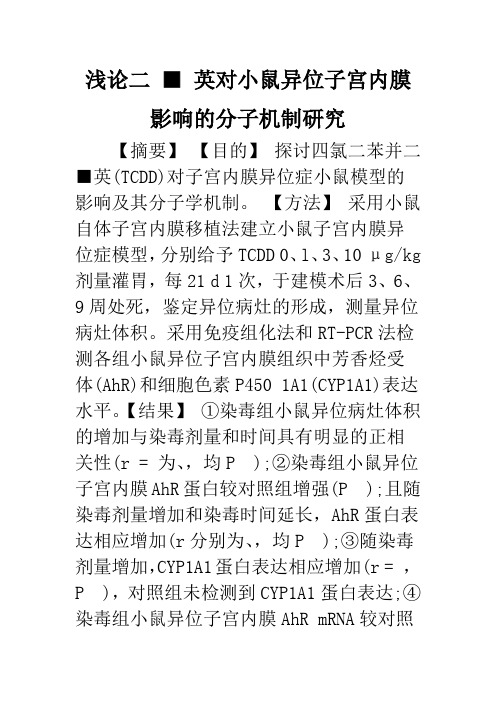
浅论二■ 英对小鼠异位子宫内膜影响的分子机制研究【摘要】【目的】探讨四氯二苯并二■英(TCDD)对子宫内膜异位症小鼠模型的影响及其分子学机制。
【方法】采用小鼠自体子宫内膜移植法建立小鼠子宫内膜异位症模型,分别给予TCDD 0、l、3、10 μg/kg 剂量灌胃,每21 d 1次,于建模术后3、6、9周处死,鉴定异位病灶的形成,测量异位病灶体积。
采用免疫组化法和RT-PCR法检测各组小鼠异位子宫内膜组织中芳香烃受体(AhR)和细胞色素P450 1A1(CYP1A1)表达水平。
【结果】①染毒组小鼠异位病灶体积的增加与染毒剂量和时间具有明显的正相关性(r = 为、,均P );②染毒组小鼠异位子宫内膜AhR蛋白较对照组增强(P );且随染毒剂量增加和染毒时间延长,AhR蛋白表达相应增加(r分别为、,均P );③随染毒剂量增加,CYP1A1蛋白表达相应增加(r = ,P ),对照组未检测到CYP1A1蛋白表达;④染毒组小鼠异位子宫内膜AhR mRNA较对照组增强(P )。
随染毒剂量增加和暴露时间延长,AhR mRNA表达相应增加(r分别为、,P );⑤随染毒剂量的增加,CYP1A1 mRNA表达明显增加(r = ,P ),对照组小鼠异位子宫内膜病灶中未检测到CYP1A1mRNA。
【结论】 TCDD可促进小鼠模型异位子宫内膜病灶的发展,其机制可能与AhR及其下游基因CYP1A1激活有关。
AhR及CYP1A1的表达增强是二■英暴露的生化指标。
【关键词】四氯二苯并二■英; 子宫内膜异位症; 小鼠; AhR; CYP1A1Abstract:【Objective】 To investigate the effect of 2,3,7,8-tetrachlorodibenzo-p-dioxin (TCDD) on development of endometriosis in a mouse model from perspective of molecular mechanism. 【Methods】 The endometriosis mouse model was established with autotransplantation of endometrium. Twenty-one days prior to induction surgery which produces endometriosis, female mice werepretreated with 2,3,7,8-tetrachlorodibenzo-p-dioxin (TCDD) at 0, 3, or 10 mg TCDD/kg. Animals were treated again at the time of surgery and at 3, 6, and 9 weeks following surgery. Evaluation of ectopic focuses diameter were made at 3, 6, 9 weeks post surgery. The AhR and CYP1A1 expression on ectopic endometrium were identified by immunohistochemistry and RT-PCR assays. 【Results】①With increased time and dose of TCDD exposure, it produced a dose-dependent increase in endometriotic site diameter when all time points were pooled within each dose in mice (r = and respectively, both P ). ②The expression of AhR protein on ectopic focuses in mice were higher in the TCDD exposure group than those in control group, and presented time-dose dependent increase (r = and , both P ). ③The higher dose of exposureincreased, the higher CYP1A1 protein expressions enhanced (r = , P ). ④As compared with the control group, the expression of AhR mRNA in ectopic focuses of mice were higher in the TCDD exposure group, and show time-dose dependent increase (r = and , both P ). ⑤The higher dose of exposure increased, the higher CYP1A1 mRNA expression enhanced (r = , P ). 【Conclusion】 TCDD can promote progression of ectopic focus of endometriosis in the mouse 子宫内膜异位症(endometriosis,EMS)是育龄妇女的常见病,但其发病机制尚不清楚。
活血消异方对子宫内膜异位症模型小鼠子宫内膜容受性的影响研究
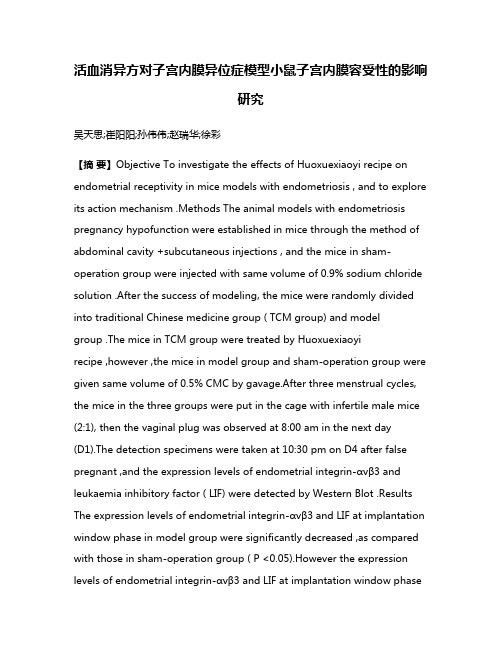
活血消异方对子宫内膜异位症模型小鼠子宫内膜容受性的影响研究吴天思;崔阳阳;孙伟伟;赵瑞华;徐彩【摘要】Objective To investigate the effects of Huoxuexiaoyi recipe on endometrial receptivity in mice models with endometriosis , and to explore its action mechanism .Methods The animal models with endometriosis pregnancy hypofunction were established in mice through the method of abdominal cavity +subcutaneous injections , and the mice in sham-operation group were injected with same volume of 0.9% sodium chloride solution .After the success of modeling, the mice were randomly divided into traditional Chinese medicine group ( TCM group) and modelgroup .The mice in TCM group were treated by Huoxuexiaoyirecipe ,however ,the mice in model group and sham-operation group were given same volume of 0.5% CMC by gavage.After three menstrual cycles, the mice in the three groups were put in the cage with infertile male mice (2:1), then the vaginal plug was observed at 8:00 am in the next day(D1).The detection specimens were taken at 10:30 pm on D4 after false pregnant ,and the expression levels of endometrial integrin-αvβ3 and leukaemia inhibitory factor ( LIF) were detected by Western Blot .Results The expression levels of endometrial integrin-αvβ3 and LIF at implantation window phase in model group were significantly decreased ,as compared with those in sham-operation group ( P <0.05).However the expression levels of endometrial integrin-αvβ3 and LIF at implantation window phasein TCM group were significantly increased,as compared with those in model group ( P <0.05 ), but which were significantly lower than those in sham-operation group ( P <0.05 ).Conclusion The endometriosis has adverse effects on endometrial receptivity . Huoxuexiaoyi recipe can significantly increase the expression levels of endometrial i ntegrin αvβ3 and LIF at implantation window phase so as to improve endometrial receptivity in mice with endometriosis .%目的探讨子宫内膜异位症对子宫内膜容受性的影响机制以及活血消异方对子宫内膜异位症模型小鼠子宫内膜容受性的作用.方法通过"皮下+腹腔"同系异体子宫内膜注射的方法建立子宫内膜异位症妊娠功能低下小鼠模型,假手术予等量0 Z.9%氯化钠溶液注射.建模成功后,随机分为中药组和模型组,中药组予活血消异方干预治疗,模型组和假手术组予等量0.5%羧甲基纤维素钠(CMC)灌胃.连续治疗3个周期后,3组分别与不育雄鼠合笼,次日清晨8:00观察阴栓,见栓者定为假孕第1天,于假孕第4天晚上10:30取材,运用Western blot法检测小鼠子宫内膜整合素αvβ3和LIF的蛋白表达.结果模型组小鼠种植窗口期子宫内膜整合素αvβ3和LIF的蛋白表达量较假手术组显著降低,差异有统计学意义(P<0.05);中药组小鼠种植窗口期子宫内膜整合素αvβ3和LIF的蛋白表达量较模型组显著升高,差异有统计学意义(P<0.05),但均低于假手术组(P<0.05).结论子宫内膜异位症对子宫内膜容受性存在不良影响.活血消异方能够显著提高小鼠围着床期子宫内膜着床因子整合素αvβ3和LIF的蛋白表达量,从而改善子宫内膜异位症模型小鼠子宫内膜容受性.【期刊名称】《河北医药》【年(卷),期】2017(039)007【总页数】4页(P965-967,972)【关键词】子宫内膜异位症;子宫内膜容受性;活血消异方;整合素αvβ3;LIF【作者】吴天思;崔阳阳;孙伟伟;赵瑞华;徐彩【作者单位】100053 北京市,中国中医科学院广安门医院妇科;100053 北京市,中国中医科学院广安门医院妇科;100053 北京市,中国中医科学院广安门医院妇科;100053 北京市,中国中医科学院广安门医院妇科;北京中医药大学【正文语种】中文【中图分类】R711.71子宫内膜异位症(endometriosis,EM)简称内异症,是指活性的子宫内膜腺体和间质种植于子宫腔以外的部位浸润性生长,引起慢性盆腔痛、不孕、月经失调等一系列临床表现的一种雌激素依赖性疾病。
ERβ对子宫内膜异位症小鼠模型的影响
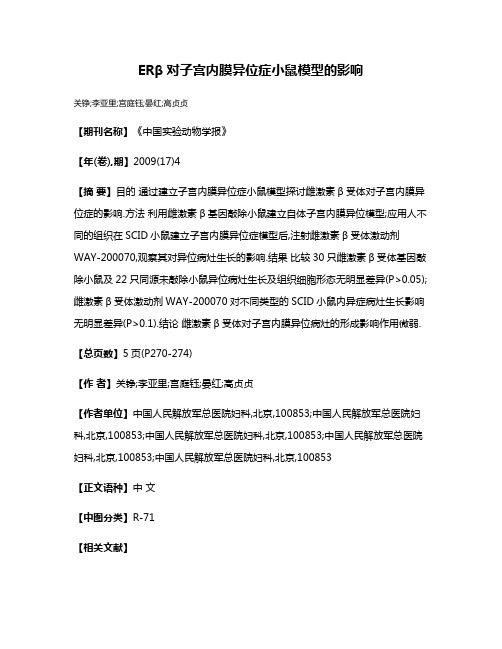
ERβ对子宫内膜异位症小鼠模型的影响关铮;李亚里;宫庭钰;晏红;高贞贞【期刊名称】《中国实验动物学报》【年(卷),期】2009(17)4【摘要】目的通过建立子宫内膜异位症小鼠模型探讨雌激素β受体对子宫内膜异位症的影响.方法利用雌激素β基因敲除小鼠建立自体子宫内膜异位模型;应用人不同的组织在SCID小鼠建立子宫内膜异位症模型后,注射雌激素β受体激动剂WAY-200070,观察其对异位病灶生长的影响.结果比较30只雌激素β受体基因敲除小鼠及22只同源未敲除小鼠异位病灶生长及组织细胞形态无明显差异(P>0.05);雌激素β受体激动剂WAY-200070对不同类型的SCID小鼠内异症病灶生长影响无明显差异(P>0.1).结论雌激素β受体对子宫内膜异位病灶的形成影响作用微弱.【总页数】5页(P270-274)【作者】关铮;李亚里;宫庭钰;晏红;高贞贞【作者单位】中国人民解放军总医院妇科,北京,100853;中国人民解放军总医院妇科,北京,100853;中国人民解放军总医院妇科,北京,100853;中国人民解放军总医院妇科,北京,100853;中国人民解放军总医院妇科,北京,100853【正文语种】中文【中图分类】R-71【相关文献】1.二恶英对小鼠模型子宫内膜异位症的影响 [J], 刘娟;任慕兰2.子宫内膜异位症中ER-α和ER-β研究进展 [J], 龙晓宇;关咏梅;傅松滨3.ERα、ERβ、pS2及其在子宫内膜异位症中表达的研究现状 [J], 卢静;冯鸽;迟小岩4.ERα、ERβ、pS2及其在子宫内膜异位症中表达的研究现状 [J], 卢静; 冯鸽; 迟小岩5.子宫内膜异位症患者在位和异位内膜上皮细胞ER-α、ER-β的检测 [J], 龙晓宇;关咏梅因版权原因,仅展示原文概要,查看原文内容请购买。
子宫内膜异位症小鼠巨噬细胞移动抑制因子变化规律的研究
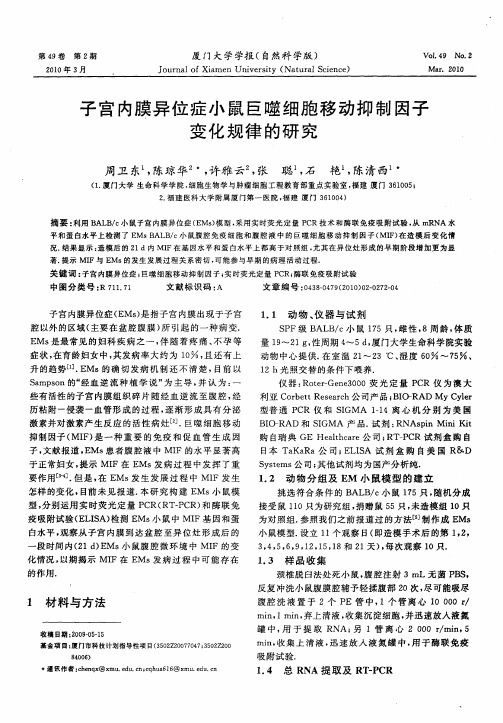
化 情况 , 以期 揭示 MI F在 E Ms发 病 过 程 中 可 能存 在 的作 用.
1 3 样 品收 集 . 颈椎 脱 臼法处死 小 鼠, 腹腔 注射 3mL无 菌 P S B,
型普 通 P R 仪 和 S GMA 11 C I —4离 心 机 分 别 为 美 国
B O— AD和 S G I R I MA 产 品. 剂 : NAs i n Ki 试 R pn Mii t
激 素并对激 素产 生 反应 的活性 病 灶 [ . 2 巨噬 细胞 移 动 ] 抑制 因子 ( F 是 一 种 重 要 的免 疫 和促 血 管 生 成 因 MI ) 子 , 献报道 , Ms 者腹 腔液 中 MI 文 E 患 F的水 平显 著 高 于正 常妇 女 , 提示 MI F在 E Ms发病 过 程 中发 挥 了重 要 作用[ ] 但是 , E 3. 在 Ms发 生发 展 过 程 中 MI F发 生 怎样 的变化 , 目前 未见 报道 . 研究 构建 E 本 Ms小 鼠模 型, 分别运用 实 时荧 光 定 量 P R( T P R) C R — C 和酶 联 免
量 1  ̄2 , 9 1g 性周期 4 , 门大学 生命 科 学 院实 验 ~5d 厦
动 物 中心 提供 . 室 温 2 ~ 2 在 1 3℃ 、 湿度 6 ~ 7 、 O 5 1 2h光 照交 替的条 件下 喂养. 仪 器 : trGe e0 0荧 光 定 量 P R 仪 为 澳 大 Roe- n 3 0 C
著 . 示 MI 提 F与 E Ms 发 生 发展 过 程 关 系密 切 , 能参 与早 期 的病 理 活 动 过 程 . 的 可
关键 词 : 子宫 内膜异位症 ; 巨噬细胞移 动抑 制因子 ; 时荧光定量 P R; 实 C 酶联免疫吸附试验
子宫内膜异位症动物模型研究进展
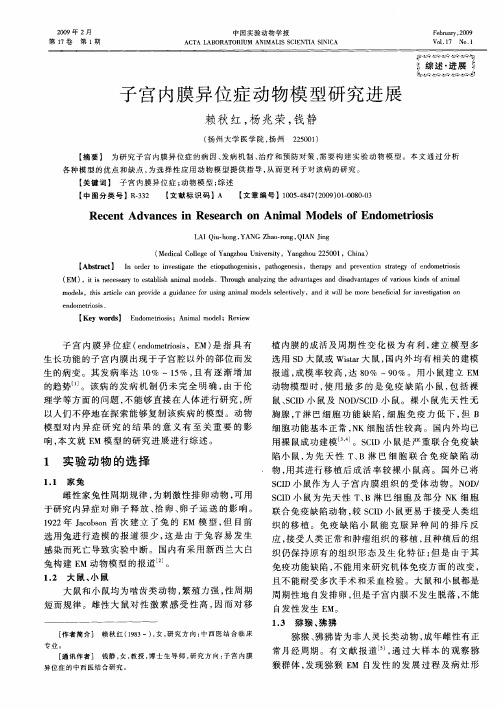
【 yw rs E dm toi; n a m dl ei Ke od】 no ei s A i l oe;R v w rs m e
子 宫 内 膜 异 位 症 ( no e i i,E 是 指 具 有 edm to s M) rs
植 内膜 的成 活及周 期 性变 化 极 为有 利 , 建立 模 型多 选用 s D大 鼠或 Wia 大 鼠, sr t 国内外 均有 相关的建模
2 0 年 2月 09
中 国实 验 动 物学 报
AC A L B0R 0RI T AT UM ANI L S S I T A S NI A MA I C EN I I C
F bur ,0 9 eray 2 0 Vn . 7 N 1 I 1 o.
第 1 7卷
第 1 期
生长功 能 的子 宫 内膜 出现 于子宫 腔 以外 的部 位而 发
生的病变 。其 发病 率 达 1 % ~1 %, 有 逐 渐增 加 0 5 且 的趋势¨ 。该 病 的发 病 机制 仍 未 完 全 明 确 , 由于伦 理学等方 面 的问题 , 不能够 直接 在人体 进行研 究 , 所 以人们 不停地 在探 索能够 复制该 疾病 的模 型 。动 物
( dclC l g f a ghu U iesy,Y n zo 2 0 1 hn ) Me ia ol eo n zo nv rt e Y i a ghu2 5 0 ,C ia
小鼠子宫内膜异位模型
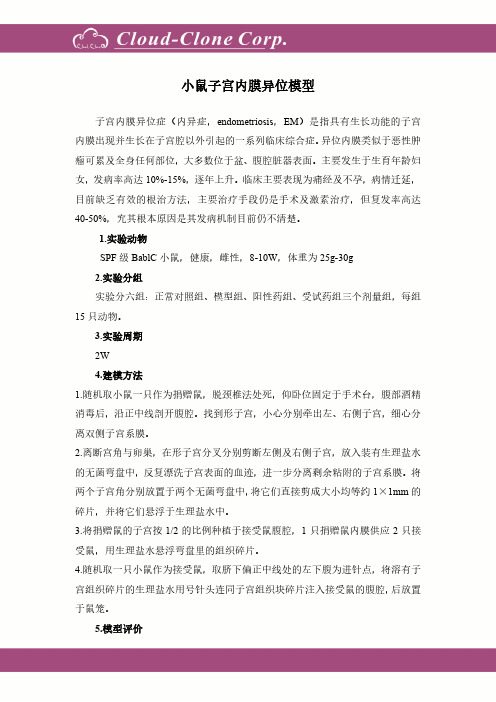
小鼠子宫内膜异位模型子宫内膜异位症(内异症,endometriosis,EM)是指具有生长功能的子宫内膜出现并生长在子宫腔以外引起的一系列临床综合症。
异位内膜类似于恶性肿瘤可累及全身任何部位,大多数位于盆、腹腔脏器表面。
主要发生于生育年龄妇女,发病率高达10%-15%,逐年上升。
临床主要表现为痛经及不孕,病情迁延,目前缺乏有效的根治方法,主要治疗手段仍是手术及激素治疗,但复发率高达40-50%,究其根本原因是其发病机制目前仍不清楚。
1.实验动物SPF级BablC小鼠,健康,雌性,8-10W,体重为25g-30g2.实验分组实验分六组:正常对照组、模型组、阳性药组、受试药组三个剂量组,每组15只动物。
3.实验周期2W4.建模方法1.随机取小鼠一只作为捐赠鼠,脱颈椎法处死,仰卧位固定于手术台,腹部酒精消毒后,沿正中线剖开腹腔。
找到形子宫,小心分别牵出左、右侧子宫,细心分离双侧子宫系膜。
2.离断宫角与卵巢,在形子宫分叉分别剪断左侧及右侧子宫,放入装有生理盐水的无菌弯盘中,反复漂洗子宫表面的血迹,进一步分离剩余粘附的子宫系膜。
将两个子宫角分别放置于两个无菌弯盘中,将它们直接剪成大小均等约1×1mm的碎片,并将它们悬浮于生理盐水中。
3.将捐赠鼠的子宫按1/2的比例种植于接受鼠腹腔,1只捐赠鼠内膜供应2只接受鼠,用生理盐水悬浮弯盘里的组织碎片。
4.随机取一只小鼠作为接受鼠,取脐下偏正中线处的左下腹为进针点,将溶有子宫组织碎片的生理盐水用号针头连同子宫组织块碎片注入接受鼠的腹腔,后放置于鼠笼。
5.模型评价1.大体观察:建模后第7天处死小鼠开腹观察病灶,成活病灶表现为多种形态,呈红色、蓝色、紫红色、白色、橙色等小泡,部分与周围粘连。
2.建模后异位内膜组织学变化可见丰富的腺体及间质细胞,腺体结构正常,血管丰富。
病灶图1 建模7天后大体病灶。
活血消异方对子宫内膜异位症模型小鼠体外受精胚胎发育的影响
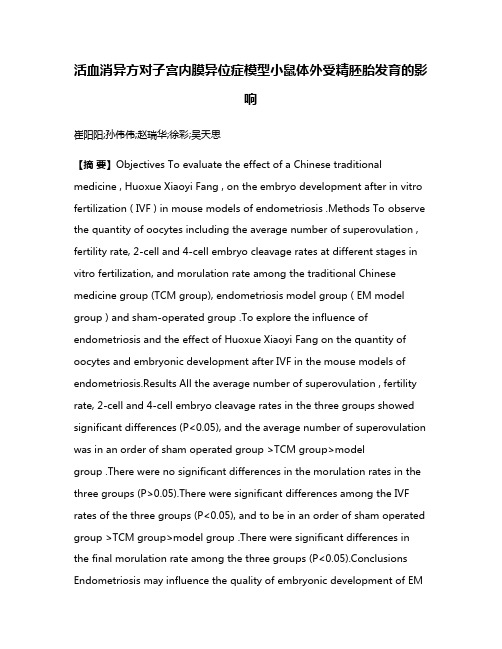
活血消异方对子宫内膜异位症模型小鼠体外受精胚胎发育的影响崔阳阳;孙伟伟;赵瑞华;徐彩;吴天思【摘要】Objectives To evaluate the effect of a Chinese traditional medicine , Huoxue Xiaoyi Fang , on the embryo development after in vitro fertilization ( IVF ) in mouse models of endometriosis .Methods To observe the quantity of oocytes including the average number of superovulation , fertility rate, 2-cell and 4-cell embryo cleavage rates at different stages in vitro fertilization, and morulation rate among the traditional Chinese medicine group (TCM group), endometriosis model group ( EM model group ) and sham-operated group .To explore the influence of endometriosis and the effect of Huoxue Xiaoyi Fang on the quantity of oocytes and embryonic development after IVF in the mouse models of endometriosis.Results All the average number of superovulation , fertility rate, 2-cell and 4-cell embryo cleavage rates in the three groups showed significant differences (P<0.05), and the average number of superovulation was in an order of sham operated group >TCM group>modelgroup .There were no significant differences in the morulation rates in the three groups (P>0.05).There were significant differences among the IVF rates of the three groups (P<0.05), and to be in an order of sham operated group >TCM group>model group .There were significant differences in the final morulation rate among the three groups (P<0.05).Conclusions Endometriosis may influence the quality of embryonic development of EMmodel mice, including reduced average number of superovulation , fertility rate, and embryo cleavage rate .The Chinese traditional medicine Huoxue Xiaoyi Fang can improve the the quantity of embryonic development after IVF .%目的:评估活血消异方子宫内膜异位症模型小鼠体外受精胚胎发育的影响。
NF-kappaBp50基因敲除小鼠子宫内膜异位症模型的建立及其研究
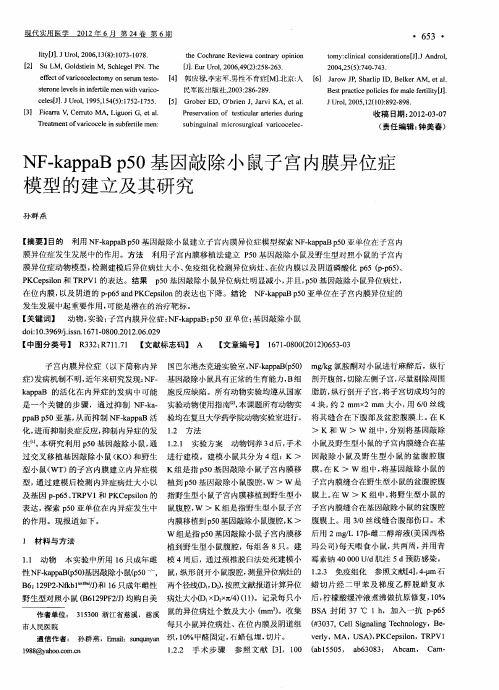
膜异位症动物模型, 检测建模 后异位病灶大小、 免疫组化检测异位病灶 、 在位 内膜 以及阴道磷酸化 p 5(.6) 6 pp 5、
P e so KC pi n和 T P l R V1的表 达 。结 果 p 0基 因敲 除 小 鼠异 位 病 灶 明 显减 小 , 5 并且 ,5 因 敲 除 小 鼠异位 病 灶 , p 0基 NFk pa 5 .apBp 0亚单 位 在 子 宫 内膜 异 位 症 的 在 位 内膜 , 以及 阴道 的 Pp 5 n P C pi n的 表达 也下 降 。结 论 —6 d K es o a l
入 相 应 的二 抗 染 色 , 抗 为 H P 记 的 00 6 01 2 07 9 O 7 , 组 间表 达 二 R 标 .5 、 . 、 .1 和 . 0 各 9 0 T P 主 要表达 与神经 元 , R V1 近年 的研
相 应 针 对 一 抗 种 属 的抗 体 , 工 作 浓 度 差 异 显著 (= .O )而 T P 在 各 组 究 也提 示可 能表达 于 人支气 管 上皮细 胞 、 P O 5; O R V1
【J Gr b rE O’r n J J r i 5 o e D, b i , a v e KA, t 1 e . a
Pr s r t n o t si u a r re u i g e e vai f e t l ra t i s d rn o c e
s b ng i lm i r s r i a a i o e e — u i u na c o u g c l v rc c lc
2 Q 2年 6月 第 2 1 4卷 第 6
lyJ. o, 0 6l() 03 17 . i []J l2 0 ,38: 7 .0 8 t Ur 1
子宫内膜异位症啮齿类动物模型研究进展
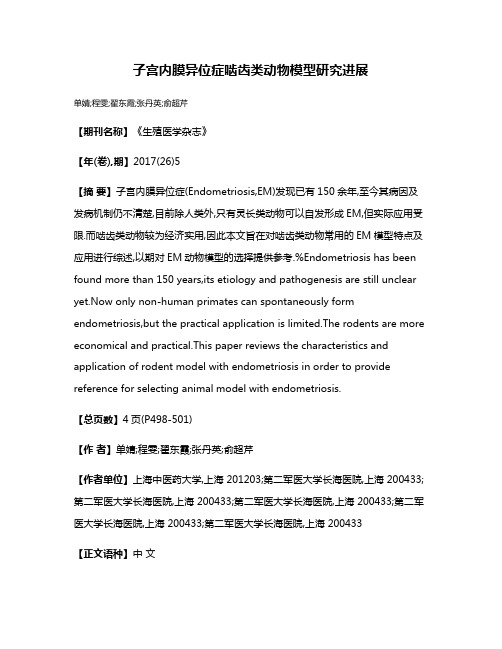
子宫内膜异位症啮齿类动物模型研究进展单婧;程雯;翟东霞;张丹英;俞超芹【期刊名称】《生殖医学杂志》【年(卷),期】2017(26)5【摘要】子宫内膜异位症(Endometriosis,EM)发现已有150余年,至今其病因及发病机制仍不清楚,目前除人类外,只有灵长类动物可以自发形成EM,但实际应用受限.而啮齿类动物较为经济实用,因此本文旨在对啮齿类动物常用的EM模型特点及应用进行综述,以期对EM动物模型的选择提供参考.%Endometriosis has been found more than 150 years,its etiology and pathogenesis are still unclear yet.Now only non-human primates can spontaneously form endometriosis,but the practical application is limited.The rodents are more economical and practical.This paper reviews the characteristics and application of rodent model with endometriosis in order to provide reference for selecting animal model with endometriosis.【总页数】4页(P498-501)【作者】单婧;程雯;翟东霞;张丹英;俞超芹【作者单位】上海中医药大学,上海 201203;第二军医大学长海医院,上海 200433;第二军医大学长海医院,上海 200433;第二军医大学长海医院,上海 200433;第二军医大学长海医院,上海 200433;第二军医大学长海医院,上海 200433【正文语种】中文【相关文献】1.卒中后抑郁啮齿类动物模型的建立与评价研究进展 [J], 王倩;由凤秋;熊婧;田晔2.建立啮齿类酒精饮用动物模型的影响因素及研究进展 [J], 刘欣;张倩倩;王圣霞;张旺信;张汉霆3.甲状腺疾病啮齿类动物模型的研究进展 [J], 塔拉;金山4.创伤后应激障碍的啮齿类动物模型研究进展 [J], 孙浩然; 徐艳玲; 李长江; 连波; 王艳郁; 孙琳5.重度抑郁症啮齿类动物模型研究进展 [J], 周珺;许向阳;张长青;罗欢;张玲;蒋钰;胡一桥因版权原因,仅展示原文概要,查看原文内容请购买。
子宫内膜异位症对小鼠生育能力的影响
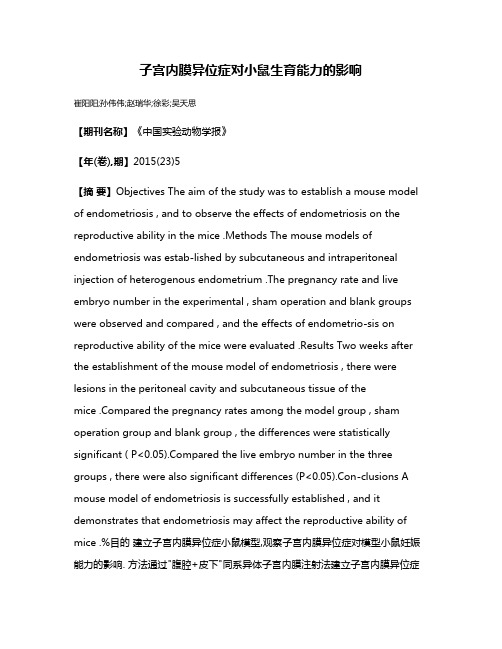
子宫内膜异位症对小鼠生育能力的影响崔阳阳;孙伟伟;赵瑞华;徐彩;吴天思【期刊名称】《中国实验动物学报》【年(卷),期】2015(23)5【摘要】Objectives The aim of the study was to establish a mouse model of endometriosis , and to observe the effects of endometriosis on the reproductive ability in the mice .Methods The mouse models of endometriosis was estab-lished by subcutaneous and intraperitoneal injection of heterogenous endometrium .The pregnancy rate and live embryo number in the experimental , sham operation and blank groups were observed and compared , and the effects of endometrio-sis on reproductive ability of the mice were evaluated .Results Two weeks after the establishment of the mouse model of endometriosis , there were lesions in the peritoneal cavity and subcutaneous tissue of themice .Compared the pregnancy rates among the model group , sham operation group and blank group , the differences were statistically significant ( P<0.05).Compared the live embryo number in the three groups , there were also significant differences (P<0.05).Con-clusions A mouse model of endometriosis is successfully established , and it demonstrates that endometriosis may affect the reproductive ability of mice .%目的建立子宫内膜异位症小鼠模型,观察子宫内膜异位症对模型小鼠妊娠能力的影响. 方法通过"腹腔+皮下"同系异体子宫内膜注射法建立子宫内膜异位症小鼠模型,与假手术组、空白组比较,观察其妊娠率及活胎率,观察子宫内膜异位症对模型小鼠妊娠能力的影响. 结果建模2周后,小鼠皮下和腹腔均见有子宫内膜异位病灶生成,模型组、假手术组和空白组,共三组. 通过生育功能检测,三组妊娠率差异有显著性意义(P<0.05). 三组的活胎数差异有显著性意义(P<0.05). 结论成功建立子宫内膜异位症小鼠模型,并证实子宫内膜异位症可影响模型小鼠生育功能.【总页数】5页(P479-483)【作者】崔阳阳;孙伟伟;赵瑞华;徐彩;吴天思【作者单位】中国中医科学院广安门医院妇科,北京 100053;中国中医科学院广安门医院妇科,北京 100053;中国中医科学院广安门医院妇科,北京 100053;中国中医科学院广安门医院妇科,北京 100053;中国中医科学院广安门医院妇科,北京100053;北京中医药大学,北京 100029【正文语种】中文【中图分类】Q95-33【相关文献】1.轻度子宫内膜异位症伴不孕患者应用腹腔镜联合亮丙瑞林治疗的临床效果及对患者生育能力的影响 [J], 杨晓菁;张埃姆2.腹腔镜联合术后药物治疗对轻度子宫内膜异位症合并不孕患者的生育能力影响[J], 唐慧3.子宫内膜异位症合并不孕患者术后药物干预对生育能力影响 [J], 李波;洛若愚;4.子宫内膜异位症合并不孕患者术后药物干预对生育能力影响 [J], 李波;洛若愚5.孕三烯酮、米非司酮和GnRHa对有生育需求的重度子宫内膜异位症患者生育能力的影响对比 [J], 田冬艳因版权原因,仅展示原文概要,查看原文内容请购买。
子宫内膜异位症动物模型研究进展.doc
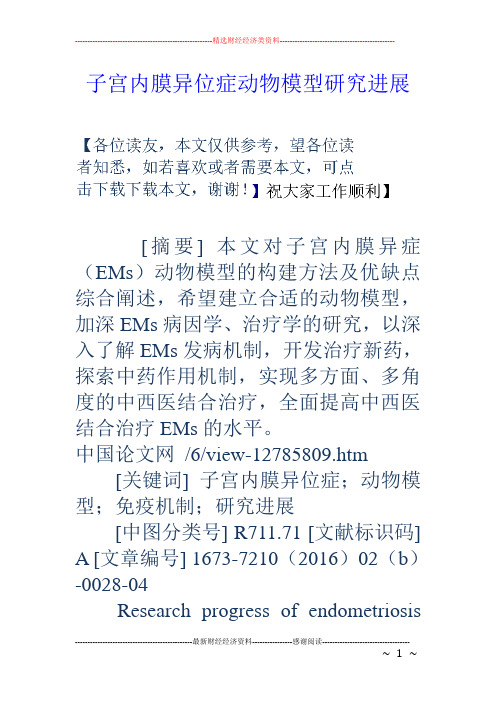
子宫内膜异位症动物模型研究进展[摘要] 本文对子宫内膜异症(EMs)动物模型的构建方法及优缺点综合阐述,希望建立合适的动物模型,加深EMs病因学、治疗学的研究,以深入了解EMs发病机制,开发治疗新药,探索中药作用机制,实现多方面、多角度的中西医结合治疗,全面提高中西医结合治疗EMs的水平。
中国论文网/6/view-12785809.htm[关键词] 子宫内膜异位症;动物模型;免疫机制;研究进展[中图分类号] R711.71 [文献标识码] A [文章编号] 1673-7210(2016)02(b)-0028-04Research progress of endometriosisanimal modelsJIN Jiyun1 XIA Qinhua21.The First School of Clinical Medicine,Nanjing University of Chinese Medicine,Jiangsu Province,Nanjing 210029,China;2.Department of Gynaecology,Jiangsu Provincial Hospital of TCM,Jiangsu Province,Nanjing 210029,China[Abstract] This paper makes a summarization for the construction method and advantages and disadvantages of endometriosis (EMs)animal models,try to establish more appropriate animal models for the study of etiology and treatment on Ems,so as to deeply know about the pathogenesis of Ems,exploit new drugs,explore mechanism of traditional Chinese medicine,realize combined treatment of traditional Chinese medicine and Western medicine from many aspects and angles,improve thelevel of combined treatment of traditional Chinese medicine and Western medicine for EMs comprehensively.[Key words] Endometriosis;Animal models;Immune mechanism;Research progress子宫内膜异位症(EMs)是指有活性的子宫内膜在被覆内膜的宫腔和子宫以外的部位生长、浸润,从而引发疼痛、结节、月经紊乱以及不孕等症的疾病。
子宫内膜异位症综述英文
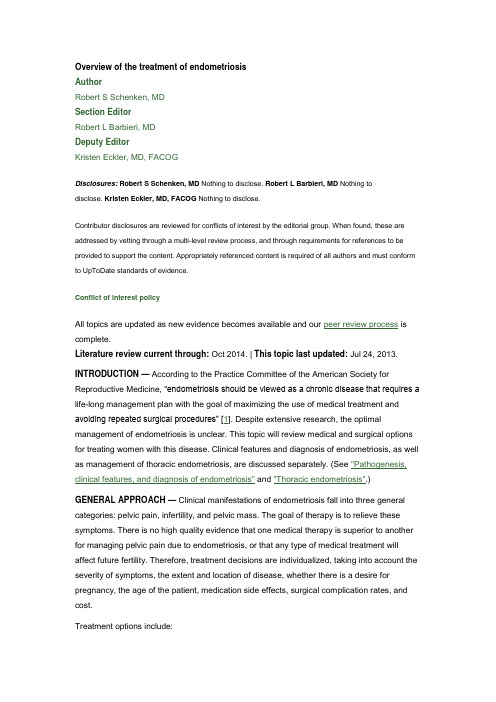
Overview of the treatment of endometriosisAuthorRobert S Schenken, MDSection EditorRobert L Barbieri, MDDeputy EditorKristen Eckler, MD, FACOGDisclosures:Robert S Schenken, MD Nothing to disclose. Robert L Barbieri, MD Nothing todisclose. Kristen Eckler, MD, FACOG Nothing to disclose.Contributor disclosures are reviewed for conflicts of interest by the editorial group. When found, these are addressed by vetting through a multi-level review process, and through requirements for references to be provided to support the content. Appropriately referenced content is required of all authors and must conform to UpToDate standards of evidence.Conflict of interest policyAll topics are updated as new evidence becomes available and our peer review process is complete.Literature review current through: Oct 2014. | This topic last updated: Jul 24, 2013. INTRODUCTION— According to the Practice Committee of the American Society for Reproductive Medicine, ―endometriosis should be viewed as a chronic disease that requires a life-long management plan with the goal of maximizing the use of medical treatment and avoiding repeated surgical procedures‖ [1]. Despite extensive research, the optimal management of endometriosis is unclear. This topic will review medical and surgical options for treating women with this disease. Clinical features and diagnosis of endometriosis, as well as management of thoracic endometriosis, are discussed separately. (See "Pathogenesis, clinical features, and diagnosis of endometriosis" and "Thoracic endometriosis".)GENERAL APPROACH— Clinical manifestations of endometriosis fall into three general categories: pelvic pain, infertility, and pelvic mass. The goal of therapy is to relieve these symptoms. There is no high quality evidence that one medical therapy is superior to another for managing pelvic pain due to endometriosis, or that any type of medical treatment will affect future fertility. Therefore, treatment decisions are individualized, taking into account the severity of symptoms, the extent and location of disease, whether there is a desire for pregnancy, the age of the patient, medication side effects, surgical complication rates, and cost.Treatment options include:●Expectant management●Analgesia●Hormonal medical therapy•Estrogen-progestin oral contraceptives, cyclic or continuous•Gonadotropin-releasing hormone (GnRH) agonists•Progestins, given by an oral, parenteral, or intrauterine route•Danazol•Aromatase inhibitors●Surgical intervention, which may be conservative (retain uterus and ovarian tissue) ordefinitive (removal of the uterus and possibly the ovaries)●Combination therapy in which medical therapy is given before and/or after surgeryLaparoscopy is the gold standard for establishing the diagnosis of endometriosis, and provides an opportunity for conservative surgical treatment. Therapeutic intervention is desirable at the time of diagnosis to ablate or excise implants and adhesions, thus potentially preventing or delaying disease or symptom progression. Early surgical therapy also avoids the expense and side effects of medical therapy. Potential disadvantages include inadvertent damage to adjacent organs (especially the bowel and bladder), postoperative infectious complications, and mechanical trauma to pelvic structures that may result in greater adhesion formation (see "Surgical management of pelvic pain due to endometriosis", section on'Conservative versus definitive surgery').After the initial diagnostic procedure, expectant management is considered primarily for two groups of patients: women with no or minimal symptoms and perimenopausal women. Although relief of symptoms is not as important for asymptomatic or minimally symptomatic women, these patients may benefit from therapy to retard progression of the disease because studies suggest that endometriosis is a progressive disease in most women [2]. While most studies suggest that oral estrogen-progestin contraceptives reduce the incidence of endometriosis, some suggest no effect or a slight increase [3-5].After menopause, endometriotic implant growth is suppressed as a result of markedly reduced ovarian estrogen production. Therefore, perimenopausal women with tolerable symptoms may opt for expectant management until menopause to avoid the side effects and cost of treatment. Alternatively, analgesia with nonsteroidal antiinflammatory drugs (NSAIDs) may provide acceptable results over the short-term. Young women with significant symptoms generally require more aggressive medical or surgical therapy.TREATMENT OF PELVIC PAIN— Women with pelvic pain and suspected endometriosis may be managed with empiric medical therapy prior to establishing a definitive diagnosis by laparoscopy [6,7]. We generally suggest analgesics and/or combined oral estrogen-progestincontraceptives for women with no more than mild pelvic pain and a GnRH agonist for those with moderate to severe pelvic pain. The advantages and disadvantages of medical therapyof pelvic pain in women with endometriosis are listed in the table (table 1). Although 80 to 90 percent of patients will have some improvement in symptoms with medical therapy, medical interventions neither enhance fertility nor diminish endometriomas or adhesions [8-10]. Therefore, women with suspected endometriomas and advanced stages of disease, or infertility, are more appropriately managed surgically.Initial approachAnalgesics— There are no large randomized trials evaluating the use of any analgesic for treatment of pain in women with endometriosis. In observational studies, the efficacy of analgesics was limited to pain that was no more than minimal [8]. Although NSAIDs are commonly used for analgesia, there are no high quality data showing that they are effectivefor managing pain due to endometriosis or more effective than other agents [11]. Use of NSAIDs is based on their ready availability, low cost, acceptable side effect profile, and evidence from randomized clinical trials consistently demonstrating that they are effective treatment of primary dysmenorrhea. (See "Treatment of primary dysmenorrhea in adult women".)Estrogen-progestin oral contraceptives— Estrogen-progestin oral contraceptives (OCs) are a good choice for women with minimal or mild pain who also want to prevent pregnancy. An advantage of OCs over most other hormonal interventions is that they can be taken indefinitely.A placebo-controlled randomized trial demonstrated that use of OCs is effective for relief of dysmenorrhea [12]. OCs may also retard progression of disease, but evidence is conflicting [3-5,12-17]. The purported therapeutic mechanism is decidualization and subsequent atrophy of endometrial tissue, including ectopic endometrial tissue.Cyclic OCs may not be as effective as GnRH agonists. The only randomized trial that directly compared a low-dose cyclic OC to a GnRH agonist (goserelin) reported that both drugs provided significant relief of pain, but goserelin was superior for treatment of dyspareunia [18,19]. Data on the comparative efficacy of continuous OCs are inconsistent:●A randomized trial including 133 women with relapse of endometriosis-associated paincompared treatment with a GnRH agonist plus add-back therapy, a GnRH agonist alone, and continuous monophasic OCs for 12 months [20]. Patients treated with a GnRHagonist had significantly greater reduction in pelvic pain, dysmenorrhea, anddyspareunia than patients treated with continuous OCs. The group taking a GnRHagonist plus add-back therapy had the highest quality of life scores.●In contrast, a randomized trial including 47 women with endometriosis-associatedpelvic pain that directly compared use of continuous monophasic OCs to a GnRHagonist (leuprolide with add-back) for 48 weeks found the regimens were equallyeffective in reduction of pain [21].Both trials were well-designed, but the second study was limited by the small number of patients and high drop-out rate (40 percent).Thus, it is unclear whether a cyclic, continuous, or tricycle regimen is most effective [8]. If pain does not respond well to cyclic therapy, switching to continuous OC administration may be effective [22]. A monophasic pill is adequate; there is no evidence that a triphasic pill has any advantages for treatment of endometriosis-related pain. The clinical regimen for continuous or extended use of OCs is described separately. (See "Hormonal contraception for suppression of menstruation", section on 'Extended and continuous use of contraceptive pills'.)Nonoral estrogen-progestin contraceptives (ring, patch) may also be effective, but have not been studied extensively [23].Failure of initial medical therapy— We offer hormonal interventions other than OCs to women with early stage disease who are not achieving adequate pain relief after a three- to six-month trial with analgesics or OCs and to those with recurrent mild endometriosis and pain. The rationale for use of hormonal intervention is that altering thepatient's estrogen/progesterone profile should affect the course of the disease since ovarian steroids affect the growth of endometriosis. This hypothesis is supported by the observation that pregnancy and menopause, physiologic states which cause alterations in ovarian hormone concentrations, appear to be associated with a reduction in pelvic pain.The three hormonal interventions (other than OCs) most commonly used to treat endometriosis are gonadotropin-releasing hormone (GnRH) agonist analogs, danazol, and progestins. GnRH analogs and danazol induce a state of "pseudomenopause," whereas progestins alone or in combination with estrogen hormonally mimic pregnancy.GnRH agonists— We suggest use of a GnRH agonist for treatment of moderate to severe pain associated with endometriosis. Randomized trials have shown that GnRH agonists are more effective than placebo and as effective as other medical therapies for relieving pain and reducing the size of endometriotic implants [24]. With add-back therapy, side effects are often better tolerated than those associated with a progestin or danazol. Similar to other medical treatments, GnRH agonists do not enhance fertility [10].GnRH agonists can be administered by daily nasal spray, or intramuscular injections every one to three months. Generally, initial treatment with a GnRH agonist is continued for six months. A randomized trial showed that an empiric trial of GnRH agonist therapy,without surgical/histological confirmation of disease, is reasonable in patients withdysmenorrhea or chronic pelvic pain who have not responded to NSAIDs or OCs, and in whom other causes of chronic pelvic pain have been excluded by history, physical examination, and laboratory testing [25]. Baseline tests, such as a complete blood count with differential and erythrocyte sedimentation rate, urinalysis, and testing for chlamydia and gonorrhea infection, are obtained to screen for a chronic infectious or inflammatory process. Pelvic ultrasound is highly sensitive for identifying pelvic masses and determining the origin of the mass (ovary, uterus, fallopian tube). (See "Evaluation of chronic pelvic pain in women".)A detailed discussion of the use and efficacy of GnRH agonists for treatment of endometriosis can be found separately. (See "Gonadotropin releasing hormone agonists for long-term treatment of endometriosis".)Progestins— Progestins inhibit endometriotic tissue growth by causing decidualization initially, and then atrophy. They also inhibit pituitary gonadotropin secretion and ovarian hormone production.In randomized trials and prospective observational studies, progestins alone, at appropriate doses, were an effective treatment of pelvic pain caused by endometriosis: over 80 percent of women had partial or complete pain relief with this therapy [26-30]. The effectiveness of progestins was best illustrated in a multicenter randomized trial including 274 women with surgically diagnosed endometriosis who were treated with intramuscular injections of DMPA-SC (104 mg) or leuprolide (11.25 mg) over a six-month interval [29]. Use of DMPA was associated with a significant reduction in dysmenorrhea, dyspareunia, pelvic pain, pelvic tenderness, and pelvic induration at 12 months follow-up, and these effects were comparable to those achieved with the GnRH agonist.The effectiveness of progestins in eliminating implants and the risk of recurrent endometriosis following treatment is less well-documented. A few studies have reported significantly reduced implant scores (determined at laparoscopy) after progestin therapy [27,31].There is no evidence that high-dose oral progestin treatment is associated with the bone loss observed with GnRH agonists. Indeed, 5 mg/day of norethindrone add-back has been shown to diminish the bone loss associated with GnRH agonist therapy. Progestins also do not have as detrimental an impact on lipids as danazol. In addition, high-dose progestin regimens are typically less expensive than regimens containing a GnRH agonist. However, many women do not tolerate high dose progestin treatment because of weight gain, irregularuterine bleeding/spotting, and mood changes (eg, depression). For these reasons, we feel GnRH agonists remain the first-line treatment choice, but progestin-only treatment is a reasonable second line treatment [32].There are several options for progestin therapy. The choice depends upon the contraceptive needs of the patient, side-effect profile of the various drugs, and patient preference.●Oral medroxyprogesterone acetate (MPA) (10 mg three times a day, maximum totaldose 100 mg daily) or norethindrone acetate (5 mg daily and increased by 2.5 mg every two weeks if pain persists, maximum total dose 15 mg daily; however, most patientsbecome amenorrheic at daily doses of 5 to 10 mg). Treatment is continued for six-months [26,27].●Depot medroxyprogesterone acetate (DMPA) is given as an injection (104 to 150 mgevery three months). This therapy has been as effective as leuprolide and danazol in randomized trials [29,33,34]. Side effects include irregular menstrual bleeding, nausea, breast tenderness, fluid retention, and depression. However, prolonged use may result in loss of bone mineral density. (See "Depot medroxyprogesterone acetate forcontraception".)●Use of the levonorgestrel-releasing intrauterine device (LNG-IUD) after postoperativetreatment of endometriosis has been evaluated in several small randomized trials [35-40]. At approximately one-year follow-up, most trials found that the LNG-IUD resulted ina significant improvement compared with pretreatment testing or expectantmanagement in measures of chronic pelvic pain and dysmenorrhea, but not ofdyspareunia. The LNG-IUD was equally or less effective than GnRH agonists inpreventing recurrence of chronic pelvic pain or dysmenorrhea following surgery [38,39].Irregular menstrual bleeding and amenorrhea are common side effects, but in contrast to depot medroxyprogesterone acetate, bone density is preserved [36]. Each LNG-IUD has sufficient LNG to be effective for five years. After five years of use, the deviceshould be removed, but can be replaced with a new device if appropriate. The LNG-IUD has few systemic side effects compared to other hormonal methods.●A small observational study and a randomized trial reported that the etonogestrelsubdermal implant (Implanon) was effective for decreasing the intensity ofendometriosis-related pain (dyspareunia, dysmenorrhea, nonmenstrual pelvic pain)[41,42]. The therapeutic effect and side-effect profile were comparable to DMPA [41].Pain was reduced by at least 50 percent after six months of use and maintained for 12 months.●A randomized trial including 253 women compared the efficacy and safety of dienogestagainst leuprolide acetate for treatment of pain associated with endometriosis [43].Dienogest 2 mg/day orally was equivalent in efficacy to leuprolide at standard dose in relieving the pain associated with endometriosis, but was associated with fewerhypoestrogenic effects (flushes, reduction in bone mineral density) and moreunscheduled bleeding.Duration of therapy— Most clinical trials of progestin therapy have been limited to 6 or 12 months duration for practical reasons. Based on clinical experience in patients with endometriosis and other disorders, progestin therapy can be extended indefinitely, if effectiveand well-tolerated. Bone loss is a concern with long-term administration of DMPA or high dose oral MPA, especially in women with risk factors for osteoporosis, but bone density generally improves if the woman returns to normal ovulatory function and estrogen production. (See "Drugs that affect bone metabolism", section on 'Medroxyprogesteroneacetate' and "Depot medroxyprogesterone acetate for contraception", section on 'Reduction in bone mineral density'.) Long-term use of norethindrone acetate can lead to a significant reduction in HDL cholesterol and significant increases in LDL cholesterol and triglycerides [44]. Given these risks, bone mineral density and lipid levels may be monitored, as appropriate, in patients on long-term therapy.Long-term use of the LNG-IUD or the etonogestrel implant does not significantly affect bone mineral density or lipid levels.Progesterone antagonists— Progesterone antagonists and selective progesterone receptor modulators have also been used successfully in pilot studies of treatment of endometriosis [45]. Use of these agents led to a reduction of both nonmenstrual pelvic pain and dysmenorrhea. An advantage of these agents is that they suppress growth of endometrial cells without suppressing estrogen's effects on other tissues. However, chronic use of progesterone antagonists appears to create histological changes in the endometrium (cystic glandular dilatation) that resemble endometrial hyperplasia [46]. The clinical significance of these changes requires further investigation. (See "Therapeutic use and adverse effects of progesterone receptor antagonists and selective progesterone receptor modulators", section on 'Endometriosis'.)Danazol— Danazol is effective in resolving implants when treating mild or moderate stagesof disease and over 80 percent of patients experience relief or improvement of pain symptoms within two months of treatment [27,47,48]. A randomized trial that compared pain sources in women treated with danazol or placebo reported a significant decrease in the level of pelvic pain, lower back pain, defecation pain, and total pain in those treated with danazol [27]. The improvement in pain scores was still present six months after discontinuation of danazol therapy.Danazol is a 19-nortestosterone derivative with progestin-like effects. Its mechanisms of action include inhibition of pituitary gonadotropin secretion, direct inhibition of endometriotic implant growth, and direct inhibition of ovarian enzymes responsible for estrogen production. Danazol is given orally in divided doses ranging from 400 to 800 mg daily, generally for six months.Most women taking danazol have side effects that can be dose-dependent, and a small percentage of patients discontinue the drug because of them. Side effects include weight gain, muscle cramps, decreased breast size, acne, hirsutism, oily skin, decreased high densitylipoprotein levels, increased liver enzymes, hot flashes, mood changes, and depression. Androgenic side effects associated with use of danazol are not treatable except by lowering the dose. By comparison, the hypoestrogenic symptoms produced by GnRH agonists can be minimized by add-back therapy.Aromatase inhibitors— Traditional hormonal interventions for endometriosis have targeted ovarian estrogen production or antagonized estrogen action. Although not approved for the treatment of pelvic pain caused by endometriosis, use of aromatase inhibitors is a novel, promising approach [49]. These agents appear to regulate local estrogen formation within the endometriotic lesions themselves, in addition to inhibiting estrogen production in the ovary, brain, and periphery (eg, adipose tissue) [49]. In endometriotic tissue, prostaglandin E2 stimulates both aromatase overexpression and activity, which results in local production of estrogens from androgens. Estrogen, in turn, induces further prostaglandin E2 formation, thereby establishing a positive feedback cycle within the lesion [50].In multiple case reports and small series and a randomized trial, aromatase inhibitors have been used (off-label) to interrupt this pathway in the treatment of severe endometriosis [51-58]. A systematic review of these studies concluded aromatase inhibitors significantly reduced pain compared with GnRH agonists alone [59].Patients may respond differently to different aromatase inhibitors [60]. The two most widely used agents are anastrozole (1 mg) or letrozole (2.5 mg) daily.It is important to remember that aromatase inhibitors cause significant bone loss with prolonged use and cannot be used as single agents in premenopausal women because they stimulate FSH release and cause multi-follicular cyst development. If these agents are used to treat pain caused by endometriosis in this population, they should be prescribed in combination with a GnRH agonist or an oral estrogen-progestin contraceptive [55] to suppress follicular development.For patients in whom use of a GnRH agonist or oral estrogen-progestin contraceptive is not possible, norethindrone acetate (5 mg) is another option. In fact, the combination of letrozole and norethisterone acetate was more effective in reducing pain and deep dyspareunia in women with rectovaginal endometriosis than norethisterone acetate alone, but letrozole was associated with a high incidence of adverse effects, cost more, and did not improve patient satisfaction or reduce recurrence of pain [61].Acupuncture— A systematic review of treatment of pain associated with endometriosis with acupuncture found only one randomized trial that met inclusion criteria [62]. In that trial (n = 67), auricular acupuncture was significantly more effective than Chinese herbal medicine for treating dysmenorrhea in women with endometriosis [63].Diet— There are no dietary guidelines for prevention or treatment of endometriosis. One study reported that a lower risk of developing endometriosis was associated with a high intake of green vegetables and fruit and an increased risk with intake of beef or other red meat or ham [64]. There was no alteration of risk of endometriosis with consumption of other food items tested, including alcohol, coffee, fish and milk. Several studies have addressed diet and dysmenorrhea, but not exclusively in patients with endometriosis. (See "Treatment of primary dysmenorrhea in adult women", section on 'Diet and vitamins'.)Surgical management— Surgery may be indicated for management of endometriosis that cannot be treated with medical therapy or to provide a definitive diagnosis. Surgical management of endometriosis is discussed in detail separately. (See "Surgical management of pelvic pain due to endometriosis".)Preoperative and postoperative medical therapyPreoperative and postoperative medical therapy is discussed in detail separately.(See "Surgical management of pelvic pain due to endometriosis", section on 'Postoperative medical therapy' and "Surgical management of pelvic pain due to endometriosis", section on 'Preoperative medical suppressive therapy'.)TREATMENT OF INFERTILITY— Although endometriosis can reduce fecundability (ie, the probability of conceiving during a monthly cycle), it does not usually completely prevent conception. The mechanism for impaired fertility may involve anatomic distortion from pelvic adhesions and endometriomas and/or production of substances (eg, prostanoids, cytokines, growth factors) which are "hostile" to normal ovarian function/ovulation, fertilization, and implantation [65].The treatment of infertility associated with endometriosis involves a combination of expectant management, surgery, and assisted reproduction techniques. Treatment with hormonal suppression is ineffective [66]. A stepwise approach to treatment of infertility in women with endometriosis can be found separately (see "Pathogenesis and treatment of infertility in women with endometriosis").TREATMENT OF PELVIC MASS— An endometrioma may be associated with symptoms of endometriosis or identified at the time of evaluation for a pelvic mass. Medical therapy is unlikely to result in complete regression of large endometriomas and precludes a definitive histologic diagnosis; therefore, surgery is the preferred therapeutic approach. Asymptomatic endometriomas are often removed to confirm the diagnosis, exclude malignancy, and prevent complications, such as rupture or torsion requiring emergency surgery. However, ovarian reserve can be diminished following surgical excision [67].Management of ovarian endometriomas is discussed in more detail separately.(See "Diagnosis and management of ovarian endometriomas".)TREATMENT OF SYMPTOMS RELATED TO DEEP ENDOMETRIOSIS— Deep infiltrating endometriosis is a term used to describe infiltrative forms of the disease that involve the uterosacral ligaments, rectovaginal septum, bowel, ureters, or bladder. The origin is probably intraperitoneal endometriotic implants that have invaded and caused inflammation of the involved tissue. Another potential etiology is growth of retroperitoneal müllerian remnants.Asymptomatic disease is managed expectantly [68]. Medical therapy is appropriate for women with bothersome symptoms, except those with obstructive uropathy or symptomatic bowel stenosis. Although medical therapy of symptomatic disease has generally been reported to be ineffective or transiently effective, with recurrence rates approaching 70 percent [69], endometriosis is a chronic disease and cessation of medical therapy may account for the high frequency of symptom recurrence. A review of studies of various hormonal treatments of rectovaginal endometriosis found that most patients receiving medical therapy for 6 to 12 months reported a significant reduction in dysmenorrhea and painful intercourse and defecation during treatment, but recurrence rates were high when medical therapy was discontinued [70].Either a continuous estrogen–progestin combination or low-dose norethindrone can be used. In women with rectovaginal or colorectal endometriosis, continuous norethisterone acetate therapy (2.5 mg/day) for 12 months has been reported to improve pelvic pain, dyspareunia, dyschezia, diarrhea, and intestinal cramping, but did not have a significant effect on constipation, feeling of incomplete evacuation, and abdominal bloating [71,72].Surgical therapy is effective for relieving pelvic pain, dyspareunia, painful defecation, and lower urinary tract symptoms [73,74]; however, recurrence rates of 30 and 43 percent at four and eight years follow-up, respectively, have been reported [75]. Medical treatment rather than repeat surgery may be useful in women with persistent symptoms [72]. Surgical resection does not enhance future pregnancy rates [76].There is no consensus on the extent of resection necessary to treat deep endometriosis. Extensive dissection in the rectovaginal septum and rectal wall dissection are often necessary and require the skill of an experienced surgeon. Performing hysterectomy and bilateral salpingoophorectomy alone is inadequate definitive therapy if endometriosis involving the bowel is left untreated. In these cases, bowel resection may be necessary [77,78].In women with endometriotic lesions infiltrating the bladder muscularis propria, partial cystectomy has been reported to result in long-term relief of symptoms [74].Surgery for deep endometriosis is associated with a relatively high risk of postoperative complications, such as de-novo or worsening voiding dysfunction, rectal dysfunction, and rectovaginal fistula [78-82].。
子宫内膜异位症SCID小鼠动物模型的构建
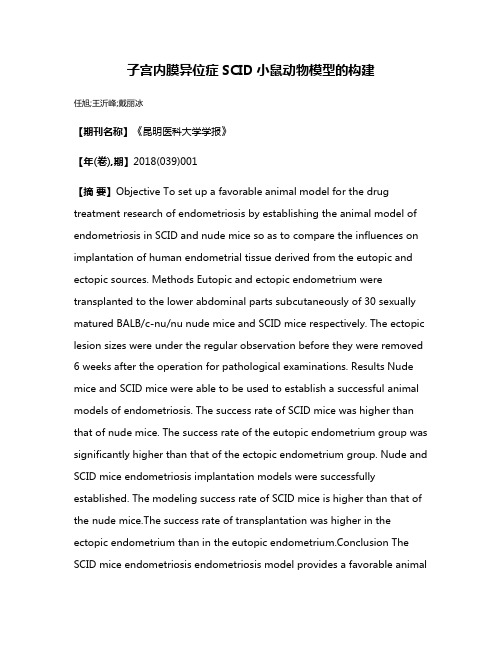
子宫内膜异位症SCID小鼠动物模型的构建任旭;王沂峰;戴丽冰【期刊名称】《昆明医科大学学报》【年(卷),期】2018(039)001【摘要】Objective To set up a favorable animal model for the drug treatment research of endometriosis by establishing the animal model of endometriosis in SCID and nude mice so as to compare the influences on implantation of human endometrial tissue derived from the eutopic and ectopic sources. Methods Eutopic and ectopic endometrium were transplanted to the lower abdominal parts subcutaneously of 30 sexually matured BALB/c-nu/nu nude mice and SCID mice respectively. The ectopic lesion sizes were under the regular observation before they were removed 6 weeks after the operation for pathological examinations. Results Nude mice and SCID mice were able to be used to establish a successful animal models of endometriosis. The success rate of SCID mice was higher than that of nude mice. The success rate of the eutopic endometrium group was significantly higher than that of the ectopic endometrium group. Nude and SCID mice endometriosis implantation models were successfully established. The modeling success rate of SCID mice is higher than that of the nude mice.The success rate of transplantation was higher in the ectopic endometrium than in the eutopic endometrium.Conclusion The SCID mice endometriosis endometriosis model provides a favorable animalmodel of endometriosis.%目的构建子宫内膜异位症(内异症)裸鼠及SCID小鼠动物模型,比较在位及异位来源的人子宫内膜组织对移植效果的影响,为内异症的药物治疗研究提供有利的动物模型基础.方法取性成熟BALB/c-nu/nu裸鼠及SCID 小鼠各30只,通过皮下移植法,将在位及异位子宫内膜移植到下腹部皮下,定期观察异位病灶的大小,术后6周取出病灶,病理学检查.结果裸鼠及SCID小鼠均可建立成功的内异症动物模型.其中SCID小鼠的建模成功率较裸鼠更高(86.7%vs 66.7%).在位子宫内膜组种植的成功率明显高于异位子宫内膜组(100%vs 84.2%).结论SCID小鼠在位内膜皮下种植方法可成功建立内异症动物模型.【总页数】5页(P30-34)【作者】任旭;王沂峰;戴丽冰【作者单位】南方医科大学南海医院妇科,广东佛山 528244;南方医科大学珠江医院妇产科,广东广州510228;广州市红十字会医院创研所,广东广州 510220【正文语种】中文【中图分类】R711【相关文献】1.人免疫重建荷子宫内膜癌SCID小鼠动物模型的建立 [J], 徐寒子;贡震;陆谔梅;孙志华;吴强;季明华;唐金海2.中药黄芪对人免疫重建荷子宫内膜癌SCID小鼠动物模型的影响 [J], 邱艳丽;丁研;李莉3.子宫内膜异位症SCID小鼠动物模型的构建 [J], 任旭;王沂峰;戴丽冰;4.尾静脉注射HL60、HL60/ADR细胞建立SCID beige小鼠白血病动物模型的研究 [J], 张坤;徐昊淼;程涓;赵勇;许亚梅5.建立人多发性骨髓瘤NOD/SCID小鼠皮下移植瘤动物模型 [J], 丁江华;袁利亚;陈国安;因版权原因,仅展示原文概要,查看原文内容请购买。
- 1、下载文档前请自行甄别文档内容的完整性,平台不提供额外的编辑、内容补充、找答案等附加服务。
- 2、"仅部分预览"的文档,不可在线预览部分如存在完整性等问题,可反馈申请退款(可完整预览的文档不适用该条件!)。
- 3、如文档侵犯您的权益,请联系客服反馈,我们会尽快为您处理(人工客服工作时间:9:00-18:30)。
IMPLANTATION AND DEVELOPMENT OF MOUSE EGGS TRANSFERRED TO THE UTERI OF NON-PROGESTATIONAL MICE
THOMAS P. COWELL
Department of JÇoology, University of Oxford, and Department of Anatomy, University of California Medical Center, San Francisco
mice.
Bilateral ovariectomy was performed on the recipient mice by excising the ovarian fat pad. Vaginal smears of all cyclic recipient mice were taken before the transfer operation.
that the endometrium was damaged in focal areas, most of which were in the ovarian end of the left uterine horn. Although the epithelium covered most of the endometrium, it was very attenuated in many areas, especially where the endometrium was very oedematous. There was usually oedema, and leucocytic infiltration occurred in the endometrium underlying broken epithelium. In some areas, the myometrium was degenerative and oedematous.
(Received 16th May 1968)
Summary. Four-day-old mouse embryos were transferred to the uterine lumen of virgin cyclic and ovariectomized mice; the eggs 'implanted' and developed only in mice whose endometrium was previously traumatized with a glass scraper. The histology of the mechanically induced implantation sites is described and similarities to normal implan-
Transplantation of the egg to extra-uterine sites such as the anterior chamber of the eye (Fawcett, Wislocki & Waldo, 1947 ; Runner, 1947), kidney (Fawcett, 1950), spleen (Kirby, 1963b) and testis (Kirby, 1963a) demonstrates that the egg is capable of 'implantation' and limited development in a variety of nonendometrial tissues, apparently regardless of the hormonal environment.
at 8 µ and stained with Haematal 8 and Bieb damage Examination of the cyclic uterus 12 to 14 hr after traumatization revealed
the tear to about two-thirds of the way down the uterine lumen. Then, with the
cutting edge pressed against the uterine lining, the scraper was withdrawn. The instrument was rotated and the process repeated four more times. The size of the scraper used was, as a rule, as large as possible, while still allowing its free movement down the uterine lumen. Immediately after scraping, six to twenty eggs were introduced into the left uterine horn by means of a transfer apparatus described by Kirby (1963b). The tip of the micropipette used in the transfer of the eggs was flame polished to reduce the chance of its insertion into the endometrium. All instruments were sterilized before the operation.
240
Thomas P. Cowell
and, if so, to study the process of implantation, the development of the conceptus, and the effect of the developing conceptus on the uterus in this abnormal conceptus-endometrium relationship.
transfer.
INTRODUCTION
Experimental separation of maternal and embryonic elements provides a valuable means for studying the embryo-endometrial relationship during implantation and placentation.
The comparative ease of egg implantation in the extra-uterine sites contrasts with implantation in the uterus which occurs only during an endocrinologically controlled receptive period (Doyle, Gates & Noyes, 1963; Psychoyos, 1966). However, several investigators have observed implantation of tumours in cyclic mice (Hall, 1940; Stein-Werblowsky, 1962). Hall (1940) thought that sarcoma implantation in the cyclic uterus occurred at sites where the trocar used for transfer had damaged the uterine lining.
Haemangio-endotheliomata were taken from 129/J mice and placed in Pannett-Compton saline. The tumours were cut into 1-mm pieces and trans¬ ferred to the traumatized left uterine horn of each of eight ovariectomized
The recipient mouse was anaesthetized with an intraperitoneal injection of Avertin (Winthrop), and the left uterine horn exposed through a dorsolateral incision. A small tear was made in the uterus near the utero-tubal junction and a scraper, fashioned from a glass pipette (PI. 1, Fig. 1), was inserted through
tation sites are discussed.
Implanted embryos developed only to stages equivalent to 5 to 9 days of normal pregnancy, but the trophoblast continued to proliferate and invaded the endometrium, eroding maternal blood vessels and distending the uterus. In five of eight ovariectomized mice, plaques of decidual-like cells were found near the trophoblast 7 to 12 days after
